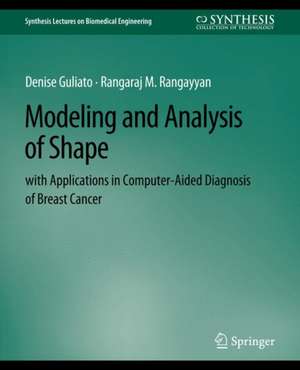Modeling and Analysis of Shape with Applications in Computer-aided Diagnosis of Breast Cancer: Synthesis Lectures on Biomedical Engineering
Autor Denise Guliato, Rangaraj Rangayyanen Limba Engleză Paperback – 14 ian 2011
Din seria Synthesis Lectures on Biomedical Engineering
- 17%
 Preț: 362.03 lei
Preț: 362.03 lei - 15%
 Preț: 522.24 lei
Preț: 522.24 lei - 5%
 Preț: 364.74 lei
Preț: 364.74 lei - 5%
 Preț: 525.89 lei
Preț: 525.89 lei - 15%
 Preț: 636.80 lei
Preț: 636.80 lei -
 Preț: 382.95 lei
Preț: 382.95 lei -
 Preț: 268.83 lei
Preț: 268.83 lei -
 Preț: 260.77 lei
Preț: 260.77 lei -
 Preț: 266.32 lei
Preț: 266.32 lei -
 Preț: 265.18 lei
Preț: 265.18 lei -
 Preț: 262.47 lei
Preț: 262.47 lei -
 Preț: 204.76 lei
Preț: 204.76 lei -
 Preț: 268.66 lei
Preț: 268.66 lei -
 Preț: 262.47 lei
Preț: 262.47 lei -
 Preț: 206.84 lei
Preț: 206.84 lei -
 Preț: 321.54 lei
Preț: 321.54 lei -
 Preț: 192.05 lei
Preț: 192.05 lei -
 Preț: 261.32 lei
Preț: 261.32 lei -
 Preț: 261.53 lei
Preț: 261.53 lei -
 Preț: 206.84 lei
Preț: 206.84 lei -
 Preț: 349.36 lei
Preț: 349.36 lei -
 Preț: 260.95 lei
Preț: 260.95 lei -
 Preț: 204.76 lei
Preț: 204.76 lei -
 Preț: 391.02 lei
Preț: 391.02 lei -
 Preț: 268.83 lei
Preț: 268.83 lei -
 Preț: 205.92 lei
Preț: 205.92 lei -
 Preț: 382.57 lei
Preț: 382.57 lei -
 Preț: 346.48 lei
Preț: 346.48 lei -
 Preț: 264.41 lei
Preț: 264.41 lei -
 Preț: 384.48 lei
Preț: 384.48 lei -
 Preț: 259.04 lei
Preț: 259.04 lei -
 Preț: 260.95 lei
Preț: 260.95 lei -
 Preț: 261.32 lei
Preț: 261.32 lei -
 Preț: 158.66 lei
Preț: 158.66 lei -
 Preț: 267.86 lei
Preț: 267.86 lei -
 Preț: 207.65 lei
Preț: 207.65 lei -
 Preț: 205.92 lei
Preț: 205.92 lei -
 Preț: 268.66 lei
Preț: 268.66 lei -
 Preț: 322.31 lei
Preț: 322.31 lei -
 Preț: 205.70 lei
Preț: 205.70 lei -
 Preț: 226.22 lei
Preț: 226.22 lei - 15%
 Preț: 404.48 lei
Preț: 404.48 lei -
 Preț: 263.28 lei
Preț: 263.28 lei -
 Preț: 383.71 lei
Preț: 383.71 lei -
 Preț: 273.45 lei
Preț: 273.45 lei -
 Preț: 207.06 lei
Preț: 207.06 lei -
 Preț: 263.06 lei
Preț: 263.06 lei -
 Preț: 260.77 lei
Preț: 260.77 lei -
 Preț: 205.33 lei
Preț: 205.33 lei
Preț: 234.87 lei
Nou
Puncte Express: 352
Preț estimativ în valută:
44.94€ • 48.06$ • 37.47£
44.94€ • 48.06$ • 37.47£
Carte tipărită la comandă
Livrare economică 14-21 aprilie
Preluare comenzi: 021 569.72.76
Specificații
ISBN-13: 9783031794285
ISBN-10: 3031794281
Ilustrații: XX, 75 p.
Dimensiuni: 191 x 235 mm
Editura: Springer International Publishing
Colecția Springer
Seria Synthesis Lectures on Biomedical Engineering
Locul publicării:Cham, Switzerland
ISBN-10: 3031794281
Ilustrații: XX, 75 p.
Dimensiuni: 191 x 235 mm
Editura: Springer International Publishing
Colecția Springer
Seria Synthesis Lectures on Biomedical Engineering
Locul publicării:Cham, Switzerland
Cuprins
Analysis of Shape.- Polygonal Modeling of Contours.- Shape Factors for Pattern Classification.- Classification of Breast Masses.
Notă biografică
Denise Guliato is an Associate Professor with the Faculdade de Computação at the Universidade Federal de Uberlândia, Uberlândia, Minas Gerais, Brazil. She received the Bachelor of Computer Science degree from the Universidade Federal de São Carlos, São Carlos, Brazil, the Master’s degree in Computer Science from the Universidade Federal do Rio Grande do Sul, Porto Alegre, Brazil, and the Ph.D. degree in Electrical Engineering from Universidade de São Paulo, São Paulo, Brazil. Her research interests include digital image processing, image analysis, pattern recognition, medical imaging and image analysis, computer[1]aided diagnosis, content-based image and video retrieval, e-learning systems, and Web services. Her current research projects are on feature extraction, analysis and classification of mammograms; computer-aided diagnosis of breast cancer; and content-based image and video retrieval using bags of visual features. Rangaraj M. Rangayyan is a Professor with the Department of Electrical and Computer Engineering, and an Adjunct Professor of Surgery and Radiology, at the University of Calgary, Calgary, Alberta, Canada. He received the Bachelor of Engineering degree in Electronics and Communication in 1976 from the University of Mysore at the People’s Education Society College of Engineering, Mandya, Karnataka, India, and the Ph.D. degree in Electrical Engineering from the Indian Institute of Science, Bangalore, Karnataka, India, in 1980. His research interests are in the areas of digital signal and image processing, biomedical signal analysis, biomedical image analysis, and computer-aided diagnosis. He has published more than 140 papers in journals and 220 papers in proceedings of conferences. His research productivity was recognized with the 1997 and 2001 Research Excellence Awards of the Department of Electrical and Computer Engineering, the 1997 Research Award of the Faculty of Engineering, and by appointment as a “University Professor” in 2003, at the University of Calgary. He is the author of two textbooks: Biomedical Signal Analysis (IEEE/ Wiley, 2002) and Biomedical Image Analysis (CRC, 2005); he has coauthored and coedited several other books. He was recognized by the IEEE with the award of the Third Millennium Medal in 2000, and he was elected as a Fellow of the IEEE in 2001, Fellow of the Engineering Institute of Canada in 2002, Fellow of the American Institute for Medical and Bio[1]logical Engineering in 2003, Fellow of SPIE: the International Society for Optical Engineering in 2003, Fellow of the Society for Imaging Informatics in Medicine in 2007, Fellow of the Canadian Medical and Biological Engineering Society in 2007, and Fellow of the Canadian Academy of Engineering in 2009. He has been awarded the Killam Resident Fellowship thrice (1998, 2002, and 2007) in support of his book-writing projects.
